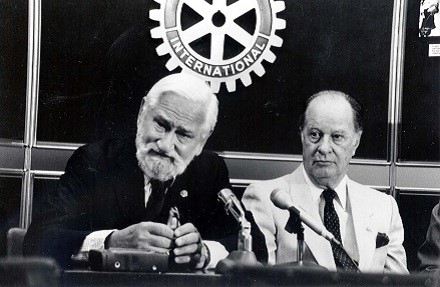Three decades of PolioPlus

During a speech to Rotary leaders in February 1985, then Rotary President Dr. Carlos Canseco announced what he considered “the biggest news in Rotary” — the commitment to help control polio worldwide.
Since that day, Rotary’s dedication to the global eradication of polio has remained constant. 2015 marks the 30th anniversary of PolioPlus and three decades of progress and challenges the program has faced.
Though the PolioPlus program started in 1985, Rotary began the fight against polio much earlier. In 1979 Rotary members began a multiyear program that immunized more than 6 million children in the Philippines against polio (Rotary.org).
Polio eradication became a top priority to Rotary after urging from Canseco, Dr. John Sever and Dr. Albert Sabin. Sever, a Rotary club leader, was the head of the infectious diseases branch of the National Institute of Neurological and Communicative Diseases and Stroke at the National Institutes of Health. As the developer of the oral polio vaccine, Sabin gave the program a globally respected figure.
With their medical backgrounds, the three became crucial spokespeople for the program. Sabin argued against the traditional country-by-country approach advocated by the World Health Organization and others in the public health community. He called it “charity,” saying that “what’s needed are annual, well-organized — I repeat, the key is well-organized — community campaigns for mass vaccination of all children under four or five years of age.” Sever, Canseco, and others joined Sabin in advocating for mass immunization.
Sever believed his fellow Rotary members meet the challenge of polio eradication, calling them a “big international army of volunteers.” He also helped Rotary secure a special designation as a nongovernmental organization affiliated with WHO in order to shape the PolioPlus program (The Rotarian).
In its early years, PolioPlus was dedicated to fundraising for immunization efforts. In May 1988 Rotary announced that the campaign, which aimed to raise $120 million, had raised nearly $220 million in contributions and pledges. That same year, the World Health Assembly set a goal of worldwide polio eradication and launched the Global Polio Eradication Initiative (GPEI) with Rotary as one of its partners. At the time, polio paralyzed more than 1,000 children worldwide every day and 125 countries were polio-endemic.
The GPEI partners, which also included WHO, UNICEF, and the U.S. Centers for Disease Control and Prevention, were able to boost world immunization levels from less than 50 percent in 1985 to over 80 percent in 1992. Just five years after the GPEI was founded, the 500 millionth child was immunized against polio. To further efforts, Rotary started the PolioPlus Partners program in 1995, to fund and support National Immunization Days in polio-endemic countries (The Rotarian).
In 2007 Rotary entered into a partnership with the Bill & Melinda Gates Foundation, which issued Rotary a $100 million challenge grant to raise funds for polio eradication. This partnership continued to grow, and in 2013 the Gates Foundation offered to match Rotary’s contributions for polio eradication 2-to-1 for five years (up to $35 million per year).
PolioPlus is truly international. Rotary has 1.2 million members in nearly every country working together to end polio for good.
Polio today:
During his 1985 speech, Canseco reminded Rotary members and the world that “Rotary cannot hope to rid the world of polio all on its own, but if we step up our efforts and add them to those of the World Health Organization’s Expanded Program on Immunization, UNICEF, and other agencies over the next two decades, we can be truly effective in accomplishing this mighty task.”
Since the launch of the GPEI, the global incidence of polio cases has decreased by 99 percent. In March 2014 India, once deemed the most difficult place to end polio, was declared polio-free, making the entire Southeast Region polio-free.
As of February 11, Africa had no new cases of wild poliovirus in six months, though the continent must mark three full years without a new case to be officially declared polio-free by WHO. Until polio is stopped in the remaining endemic areas, all countries must maintain high levels of surveillance and immunization rates to rapidly detect any importation of the poliovirus and minimize its impact. Now that 99 percent of the world’s population lives in regions certified polio-free, the goal of eradication is closer than ever.
Be a part of history and help Rotary achieve a polio-free world. Give today.
Read about the history of polio eradication efforts in “Rotary and the Gift of a Polio-Free World: Volume 1” by Sarah Gibbard Cook